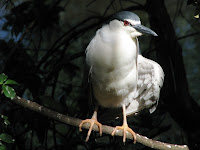 When I did some research on the title of today's blog entry, I came across a few quotes which "resound" with how I feel about nature when I e.g. look at this beautiful water-lily: "plans to protect air and water, wilderness and wildlife are in fact plans to protect man (by Stewart Udall); OR: "we forgot that the water cycle and the life cycle are one" (by Jacques Cousteau); OR: "we live by the grace of water" (from the National Geographic Special Edition, 1993).
When I did some research on the title of today's blog entry, I came across a few quotes which "resound" with how I feel about nature when I e.g. look at this beautiful water-lily: "plans to protect air and water, wilderness and wildlife are in fact plans to protect man (by Stewart Udall); OR: "we forgot that the water cycle and the life cycle are one" (by Jacques Cousteau); OR: "we live by the grace of water" (from the National Geographic Special Edition, 1993).
 Water-related to me also means admiring the bird-life found close to water - like this hamerkop, with its "truly" Afrikaans name. This water bird is distantly related to herons & storks, but is quite distinctively in a family of its own & found near freshwater. However to some Africans, the hamerkop is the "ultimate" bird of ill omen.
Water-related to me also means admiring the bird-life found close to water - like this hamerkop, with its "truly" Afrikaans name. This water bird is distantly related to herons & storks, but is quite distinctively in a family of its own & found near freshwater. However to some Africans, the hamerkop is the "ultimate" bird of ill omen.
 As is the case with most storks, the Yellowbilled stork is known as a nonbreeding, intra-African migrant to South Africa. Although found all over Africa south of the Sahara & in Madagascar during various times of the year, it's mainly a breeding resident in Zimbabwe. Most stork species are silent or simply rattle their bills, but some can vocalise with guttural croaks & squeaks.
As is the case with most storks, the Yellowbilled stork is known as a nonbreeding, intra-African migrant to South Africa. Although found all over Africa south of the Sahara & in Madagascar during various times of the year, it's mainly a breeding resident in Zimbabwe. Most stork species are silent or simply rattle their bills, but some can vocalise with guttural croaks & squeaks.
 A water bird found in most parts of the world is the Blackcrowned Night heron found near fresh as well as salt-water (mangrove) wetlands. Its scientific name, Nycticorax, means "night raven" - referring to its nocturnal habits & harsh, crow-like calls.
A water bird found in most parts of the world is the Blackcrowned Night heron found near fresh as well as salt-water (mangrove) wetlands. Its scientific name, Nycticorax, means "night raven" - referring to its nocturnal habits & harsh, crow-like calls.
 During a recent visit to the World of Birds near Plettenbergbay with our daughter & son-in-law, we admired this pair of Whitefaced (Whistling) ducks & their ducklings. However our daughter soon pointed out that something was "amiss".
During a recent visit to the World of Birds near Plettenbergbay with our daughter & son-in-law, we admired this pair of Whitefaced (Whistling) ducks & their ducklings. However our daughter soon pointed out that something was "amiss".

The tiny ducklings "represented" a mixed bunch! = they appeared to be 2 different species.

Since Whitefaced & Fulvous ducks often share the same habitat . . .
 . . . I remembered taking this photo of a Fulvous duck & tiny ducklings at the same "venue" a couple of years ago. So voila - that was the answer! The above Whitefaced ducks were rearing their own as well as a few Fulvous ducklings.
. . . I remembered taking this photo of a Fulvous duck & tiny ducklings at the same "venue" a couple of years ago. So voila - that was the answer! The above Whitefaced ducks were rearing their own as well as a few Fulvous ducklings.
 Since we were visiting a Bird-park (= "controlled" conditions), not only did the Whitefaced ducks become "adoptive" parents, but many exotic birds are also on "display" - like this Caroline Wood duck (from the northern parts of America) . . .
Since we were visiting a Bird-park (= "controlled" conditions), not only did the Whitefaced ducks become "adoptive" parents, but many exotic birds are also on "display" - like this Caroline Wood duck (from the northern parts of America) . . .

. . . or this similarly beautiful & colourful Mandarin duck (from eastern Asia or migrant of southern China).










No comments:
Post a Comment